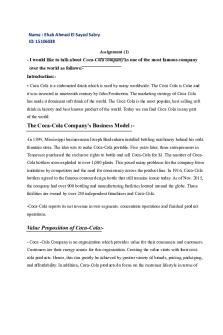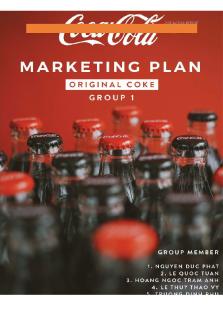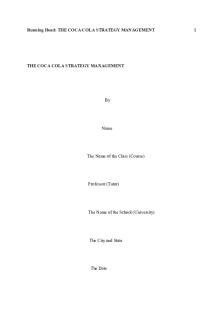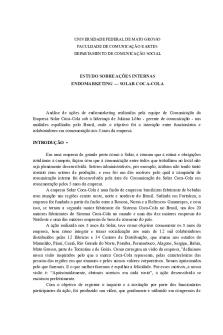COCA COLA assignment official PDF

| Title | COCA COLA assignment official |
|---|---|
| Author | Kanchan Chhetri |
| Course | General Microbiology |
| Institution | University of Washington |
| Pages | 15 |
| File Size | 664.8 KB |
| File Type | |
| Total Downloads | 24 |
| Total Views | 163 |
Summary
PMP...
Description
TABLE OF CONTENTS 1.0 Introduction................................................................................................................................2 2.0 Discussion..................................................................................................................................3 2.1 Operations Strategy................................................................................................................3 2.2 Product & Service Design......................................................................................................4 2.3 Process Design.......................................................................................................................6 2.4 Quality Management..............................................................................................................8 2.5 Supply Chain..........................................................................................................................9 3.0 Conclusion...............................................................................................................................12 References......................................................................................................................................13
EXECUTIVE SUMMARY Operations Management is a set of activities that creates goods and services through the conversion of inputs to outputs. Operations is a key element of business success and should be carefully observed in a consistent manner to achieve effectiveness and efficiency. In this assignment, we shall explore various concepts and theories relating to operations management with integration of the operations being done by Coca Cola. Throughout your reading, thorough analysis and evaluation of the strategies, product and process designs, quality management, as well as the supply chain will be encountered. Coca Cola has successfully earned for itself the title of Worlds leading soft drinks manufacturing company. Hence, we shall look at exactly how Coca Cola carries out its operations to achieve this milestone.
1.0 INTRODUCTION Coca is the world’s leading soft drinks manufacturer. Throughout its existence, Coca Cola has put great emphasis on its operations process and ensuring production is at maximum capacity in order to serve the growing demands. Coca-Cola has made available more than 500 products to the worldwide market. It has earned itself the title of world's most valuable brand, upon which this portfolio includes Diet Coke, Fanta and Sprite, and an extensive variety of other soft drinks, consisting of diet and light beverages, waters, juices, teas, energy drinks [ CITATION Coc16 \l 1033 ]. In addition, Coca-Cola holds the highest number of sales compared to other soft drinks in most countries. 94% of the world’s total population is able to recognize Coca Cola based on its distinctive red and white logo. Hence, to maintain this successful image and meet the organization’s goals it has to ensure for the proper utilization and acquisition of resources. Coca Cola currently sells an estimate of 3900 products worldwide hence, it has to carefully plan out and monitor its operations strategies to provide for its 21 million outlets[ CITATION Coc16 \l 1033 ].
Page | 2
2.0 DISCUSSION 2.1 Operations Strategy Coca Cola heavily implements process layout and product layout, meaning that several types of products are to be produced by the company in large scale production. It must ensure its strategies work alongside the layout. To better understand their strategies, the company produces goods at high volume with low variety on a continuous basis. Therefore, inputs are relatively fewer compared to output meaning that its process strategy is oriented towards product focus strategies. As a result, implementing product focus strategies leads to low flexibility in production to gain efficiency, high shut down cost, but on the other higher capital investment can be attained.
Furthermore, the operations strategies established aims to drive growth and revenue from profit. The Company utilizes segmented revenue growth methodologies over the business in a way that changed by type of markets. What's more, Coca Cola adjusts employee rewards accordingly. In developing markets, the focus is mainly on the expansion of volume produced, as well as keeping their drinks reasonable which helps to contribute towards the firm's success [CITATION Coc16 \l 1033 ]. Secondly, it tries targeting other brands and businesses as potential sources of investment meaning it aims to expand its scale of operation. In this manner, economy of scale is achieved leading to lowered unit cost of production [CITATION PSt11 \l 1033 ]. The company to put emphasis on its marketing strategies through the increase in quantity and quality of its advertisements. Coca Cola has also expanded its beverage portfolio through investment in other brands such as Suja [ CITATION Coc16 \l 1033 ]. Thirdly, it aims to continuously increase efficiency within the company. Coca Cola is working towards implementing Just-in-Time inventory. This operation strategy is likely to help release cash flow. JIT would reduce storage cost and wastage of Coca Cola. The company adopted a “zero-based work”— in other words organizational budgets would start at zero and must be justified annually, without regard to what was achieved in the previous year [ CITATION Coc16 \l 1033 ].
Page | 3
2.2 Product & Service Design Product and service design is one of the core essence of customer satisfaction. Moreover, decisions made impact the operations and the firm’s overall success. The product and service designs convert customers wants and needs into product and service requirement [CITATION Wil12 \l 1033 ]. The main actors and forces that inspires product and service design consist of market opportunities and threats. Design for Manufacturing (DFM) is also used to ensure that products are compatible with the company’s capabilities. Design for Manufacturing focuses on reducing the number of parts in an assembly line, as well as the methods and sequences that will be employed through upholding of environmental regulations and recycling. Here the focus is on designing products to allow for dis-assembly of used products for the purpose of recovering components and materials for reuse which Coca Cola does with its bottles and cans.
The company has more than 300 brands sold around the world (a few is seen in Fig 2.2a) with the most known being Coke, Fanta, and Sprite. The Coca-Cola Company adopts the widely common styles of packing which is plastic bottles. They have varying sizes of 2 liters downwards. Products are also available in aluminum cans of 375ml. Coca-Cola is the ultimate trademark in the F&B segment, recognized by 94 percent of the world population which has earned the company its competitive advantage.
Coca Cola adopts a vertically integrated system. This means that management style is expanded in order to have better control over products as they pass through distribution networks [ CITATION Isa08 \l 1033 ]. Furthermore, Coca cola has one of the largest supply chain distribution systems compared to today’s modern organizations. The coca cola export involves the selling the concentrated formula which is used to make the drink to different bottlers around the world. TCCEC takes care of processes consisting of agility, adaptability, and alignment [ CITATION Coc16 \l 1033 ].
Page | 4
Fig 2.2a – Few products from Coca Cola’s portfolio Source: www.libertycoke.com
Page | 5
2.3 Process Design Coca Cola is a soft drink producer, and heavily applies Product Focus under the process strategies. Justification revolves around the fact that there is high volume being produced by the company but there is also a low variety in the products it offers as it is limited to only certain types of soft drinks (e.g. Coke, Fanta, Sprite…). There is continuous production which is another reason why it can be categorized as Product Focus. In its manufacturing process, Coca Cola incorporates Line flow production which is the continuous movement of items through each stage of production, often along a conveyor belt or assembly line [ CITATION Jos12 \l 1033 ]. The operation follows a sequence of detailed occurrences. Also known as mass or line production, the process involves the manufacture of a large volume of identical, standardized products. Because of this implementation, Coca Cola experiences a lower variable cost per unit, alongside easy production planning and control which higher equipment utilization. In a nutshell, this process achieves economies of scale for the company as there is a reduction in the firms’ unit cost due to increasing scale of operation. This is made possible with the use of special purpose equipment [CITATION MHa13 \l 1033 ].
Layout planning plays a massive role in process design and is an important process that a company cannot miss. Layout Planning refers to the planning and organizing of all process relating to machines, tools, workstations, customer service, storage of inventories, offices and computer rooms within a facility[ CITATION MdR14 \l 1033 ]. This in turn promotes increase in work efficiency and improvement in the overall quality of the product through the planning of an effective and efficient production line and improving workers relationships. Coca Cola Company follows a standardized process for production which involves the production of large volumes of its various products.
Page | 6
Fig 2.3a – Layout of Coca Cola’s manufacturing process Source: https://www.slideshare.net/mohamedbarbario/coca-colaplantlayout
According to Stimpson (2011) Layout Product Process manufacturing process of coca cola products must undergo different steps as seen above in Fig 2.3a. Firstly, the preparation of ingredients is done in the ingredient department. Once the ingredients have been sorted they undergo a thorough cleaning process. Ingredients are sent to the washing and rinsing department whereby washing and rinsing by hydro wash is done to ensure freshness and cleanliness. Thirdly, the ingredients proceed to the mixing and blending department. This step basically makes the syrup which is used to manufacture coca cola by mixing and blending all the ingredient such as addition of sugar, carbon dioxide and other production processes. After that, the solution is sent to the tablet department which converts it to tablet form. Then, the bottling process is started which involves capping the bottle and attaching of the Coca Cola label. After that, the product undergoes inspection ensuring there is no fault. If everything appears good, the product will be packaged. Finally, once the product and packaging are completed, it can proceed to be delivered to customer.
Page | 7
2.4 Quality Management Coca Cola goes out of its way to ensure maximum quality is achieved in its products and leaving its customers satisfied. They are committed to produce and bottle drinks of the highest quality which is underpinned by the international standard ISO 22000 and ISO 9001 alongside their own specialized Quality and Food Safety Policy [CITATION The18 \l 1033 ]. In addition, Coca Cola has put in place bottle inspection equipment that ensures no harm might be caused to the consumer. This machine is designed to determine any irregularities in their bottles and discard of it. The major ingredient used in the product is water, and the company ensures that the water being used in their product is perfectly safe for consumption. This is done by undergoing microbiological safety treatments and that there is no excess of natural salts in the water. The treated and cooled water is blended with the syrup with the carbon dioxide that gives the item its unique effervescence. The product is then prepared to be bundled: each hour, a huge number of flawlessly clean compartments are filled, hermetically fixed, named, coded and tested in present day programmed plants. The glass bottles are set in boxes, while the nonreturnable glass bottles, PET containers and jars go into different multi-packs [CITATION Wil12 \l 1033 ]
Coca Cola highly utilized Quality Control and Quality Assurance in the production process. Quality control is more focused on the production line and inspection of the product, whereas Quality assurance is the systematic approach of meeting quality standards at each part of the production stage to ensure customer satisfaction [CITATION PSt11 \l 1033 ]. Basically, what coca cola does it that is has machines to check the packaging, ingredients and distribution. More specifically, the faucets, it carefully inspects the fill level of each bottles, ensures the proper labels are stuck on the product amongst other quality assuring processes. In the event that a mistake is detected, the production line will freeze and attend to the mistake and then resume operation. Overall, there is consistency in the quality monitoring process of Coca Cola, and they even take this further as to ensure their staff receive the proper training to allow for the smooth efficient operation of machineries[ CITATION Eli13 \l 1033 ]. Coca-Cola incorporates Total Quality Management (TQM), which involves the controlling and inspection of quality at every level of the organization, including; suppliers, production, customers etc. This allows Coca-Cola to retain or regain competitiveness resulting in increased customer satisfaction [CITATION AFr18 \l 1033 ]. Page | 8
Page | 9
2.5 Supply Chain “Our mission is to become the leading supply chain function in our industry in terms of customer service and cost efficiency. To achieve this, we focus our efforts on keeping our people engaged, excelling in sustainability, reducing our costs and building best-in-class customer service and responsiveness” [CITATION Mar18 \l 1033 ]. “Supply chain management is defined as the systemic, strategic coordination of the traditional business functions and the tactics across these business functions within a particular company and across businesses within the supply chain, for the purposes of improving the long-term performance of the individual companies and the supply chain as a whole” [ CITATION Xia14 \l 1033 ]. Overall, Coca Cola’s rate of production and distribution surpasses 2 billion-unit cases across their vast territories. Hence, proper management of the supply chain is important to provide effective procurement, planning, operations and manufacturing, and sustainability in order to reduce negative environment impact and promote a sustainable value chain, from the collection of raw materials until the product is being distributed to customers. [ CITATION AAm15 \l 1033 ].
This sustainable part of Coca Cola’s supply chain can be seen below in Fig 2.5a. An organization can engineer its business processes towards meeting customer needs by aligning the entire supply chain towards sustainable performance and providing the promised value to the customer on a continuous basis[ CITATION DrR14 \l 1033 ]. The Supply Chain Manager of Coca Cola Marcel Martin clearly stated that this is achieved due to their focus on maintaining maximum quality alongside investment in modern technologies. [CITATION MHa13 \l 1033 ]. In line with modern technologies, Coca Cola heavily invests in technology for optimization purposes of their infrastructure and with the aim of achieving continuous market growth which is done through expansion of their production and operations platform. Currently, its operations covers eight territories in Western Europe with a delivery rate of 600 million cases per year which are then sold to over 170 million consumers [CITATION GWh15 \l 1033 ].
Page | 10
Fig 2.5a – Sustainability in Coca Cola’s Supply Chain Source: https://sites.google.com/site/colasupplychain/
Coca Cola’s supply chain is segmented into various level. Firstly, the upstream activities are centered around the production of concentrated syrup which is then purchased by bottlers and distributors across its territories. The second level is the downstream activities which puts attention on the franchises of the company and the distribution. A summary of this whole process as described in this chapter is seen below in Fig 2.5b which looks at the manufacturing process, and Fig 2.5c which looks at the distribution of Coca Cola. In a nutshell, Coca Cola partners with loyal suppliers for the provision of the best ingredients required in its product and give out the various rage of flavors it offers. The manufacturing of the syrup is then started at the company warehouse and once product is completed, it proceeds with distribution to its regional, national and worldwide outlets.
Page | 11
Fig 2.5b Supply Chain of Coca Cola Manufacturing Process Source: www.researchgate.net
Fig 2.5c – Distribution of Coca Cola in Supply Chain Source: www.rbaonline.com Page | 12
3.0 CONCLUSION In order to come out as the world’s leading soft drink producer, Coca Cola has to take into account a lot of key elements but most specifically it must enforce consistency in its production and operations process. Maintaining this helps to achieve the highest quality and product standards which allows for the production of a product which meets the needs of their customers and reaches their expectations leading to customer satisfaction. Hence, in order to achieve these, we found that Coca Cola’s relationship with its suppliers is a key contributor. And for effective distribution, it has to build stable relationships with franchisees based on shared viewpoints on quality. Total Quality Management is at the heart of the production and operations process to ensure the company achieves what they are the are advertising for. Managing quality, layout strategy, supply chain management and inventory management plays a great importance in the production of Coca Cola. Given that production highly depends on automated machinery equipment, there must be an effective maintenance criterion and team supervising operations ensuring machines are working efficiently without any glitches. Given that Coca Cola’s plants tackles one flavor at a time, there is a requirement for a 3-4 hours cleaning period which can take away time of production. Hence, Coca Cola needs to consider this as line efficiency is vital during production and can’t afford to have time wasted. Coca Cola should aim to reduce this time lag in their production process. Benchmarking could be applied in this context and attempt to obtain ideas from its competitors. Furthermore, simultaneous production could be implemented through the investment of new machines and equipment which also helps to achieve efficiency in the production line. However, overall Coca Cola has been successful when it comes to its operations and does achieve the required standard in meeting customers’ needs and wants, earning its spot as the number one soft drink manufacturer.
Page | 13
REFERENCES A. Francis, 2018. Case Study: Quality Management System at Coca Cola Company. [Online] Available at: https://www.mbaknol.com/management-case-studies/case-study-qualitymanagement-system-at-coca-cola-company/ [Accessed 12 October 2018]. Ameen, A. & Gohar, A., 2015. Operation Management Analysis - Coca Cola, Pakistan: s.n. Aserkar, D. R., Kumthekar, N. & Aserkar, S., 2014. Investigating the Link between Supply Chain Performance and Brand Performance. International Journal of Humanities and Social Science, 4(9), pp. 231-232. Battistoni, E. & Bonacelli, A., 2013. An Analysis of the Effect of Operations Management Practices on Performance. International Journal of Engineering Business Management , 5(44), pp. 3-11. Coca-Cola inc., 2016. Coca Cola Company. [Online] Available at: https://www.cocacolacompany.com/stories/five-strategic-actions [Accessed 13 October 2018]. G. White, 2015. Manufacturing Global. [Online] Available at: https://www.manufacturingglobal.com/lean-manufacturing/factory-fridge-inside-coca-colassupply-chain [Acce...
Similar Free PDFs

COCA COLA assignment official
- 15 Pages

Coca cola assignment - finace
- 5 Pages

Coca Cola 2017-10K - Assignment
- 170 Pages

Coca cola
- 7 Pages

Coca Cola-SWOT - Coca Cola-SWOT
- 4 Pages

PROCESO ADMINISTRATIVO COCA COLA
- 1 Pages

COCA-COLA CASE STUDY
- 13 Pages

Coca Cola Strategy Management
- 9 Pages

Endomarketing - Solar Coca-Cola
- 5 Pages

Coca cola case study
- 2 Pages

Coca Cola Sustainability
- 11 Pages

Synthèse exposé coca-cola
- 2 Pages
Popular Institutions
- Tinajero National High School - Annex
- Politeknik Caltex Riau
- Yokohama City University
- SGT University
- University of Al-Qadisiyah
- Divine Word College of Vigan
- Techniek College Rotterdam
- Universidade de Santiago
- Universiti Teknologi MARA Cawangan Johor Kampus Pasir Gudang
- Poltekkes Kemenkes Yogyakarta
- Baguio City National High School
- Colegio san marcos
- preparatoria uno
- Centro de Bachillerato Tecnológico Industrial y de Servicios No. 107
- Dalian Maritime University
- Quang Trung Secondary School
- Colegio Tecnológico en Informática
- Corporación Regional de Educación Superior
- Grupo CEDVA
- Dar Al Uloom University
- Centro de Estudios Preuniversitarios de la Universidad Nacional de Ingeniería
- 上智大学
- Aakash International School, Nuna Majara
- San Felipe Neri Catholic School
- Kang Chiao International School - New Taipei City
- Misamis Occidental National High School
- Institución Educativa Escuela Normal Juan Ladrilleros
- Kolehiyo ng Pantukan
- Batanes State College
- Instituto Continental
- Sekolah Menengah Kejuruan Kesehatan Kaltara (Tarakan)
- Colegio de La Inmaculada Concepcion - Cebu
![Business - Pestle - Coca Cola in India [Official]](https://pdfedu.com/img/crop/172x258/m6rm1114yrpy.jpg)


